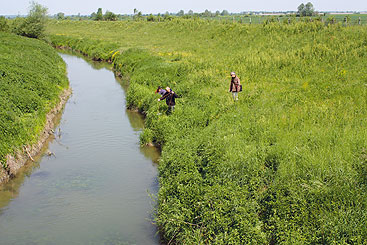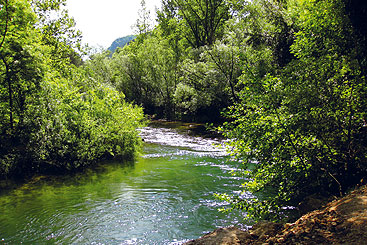
Tailor-made: Croatia’s Twinning Project
A two-year Twinning Project on EU Water Framework Directive implementation, pairing Croatia with Germany as senior twinning partner and the Netherlands as junior partner, has addressed environmental issues to ensure sustainable solutions for water management.

A significant problem in
the region is the structural
degradation of rivers,
and river regulation for
flood protection and agricultural
purposes has led
to a severe loss of river
habitats.
Croatia is a heterogenic country in terms of its economic and ecologic situation. The Dinaric part on the one hand side is dominated by karstic and coastal areas and is a popular region with tourists. The Pannonian part on the other side comprises the vast floodplains of the rivers Sava, Drava and Danube. Agriculture is the most important source of income in this region. Consequently one size fits all solutions, especially in regard to water management issues, do not apply in Croatia. Tailor-made concepts have to be developed in order to meet the objectives set by the EU Water Framework Directive (WFD).
The main WFD objective for rivers in Europe is to achieve ‘good ecological status’. While in EU Member States the results of the assessment are publicly available, there is only very limited information about the ecological status of the rivers Sava, Drava and Danube in Croatia. To get a first impression the EU Twinning Project ‘Water Framework Directive Implementation in Croatia’, together with the Croatian Ministry of Regional Development, Forestry and Water Management and its background institute ‘Croatian Waters’, launched joint actions for monitoring, risk analysis and develoing a programme of measures.
Understanding Croatia’s water status. Biological monitoring is the core of WFD compliant monitoring, and the Twinning Project strongly promoted its implementation in Croatia. A team of German and Croatian experts carried out a monitoring campaign in order to compile comparable and reliable information on the ecological status of Croatia’s transboundary rivers.
In many ways, the results were surprising. Organic pollution as indicated by aquatic insects (saprobic index) shows that there is the need to reduce impacts from households by installing adequate waste water treatment. Yet the impact is less significant than expected, as can be seen on the first saprobic map of Croatia. An overload of nutrients can also be observed and is indicated by the phytobenthos (microscopic flora found on river bed material) community in areas of intensive agriculture.
A significant but underestimated problem is the structural degradation of rivers. River regulation for flood protection and agricultural purposes has led to a severe loss of river habitats, indicated by macrophytes (free floating or attached plants), fish and macroinvertebrate communities, especially for rivers of the Pannonian flatland.

However, morphological alterations can be reduced by a more ecological-oriented maintenance, introducing the ‘give space to the rivers’ approach. Examples from Member States demonstrate that natural structures can be developed in harmony with flood protection and agricultural needs.
Managing a variety of new policies. To achieve the economic and ecological targets of the WFD it is necessary to consider other water-related directives, especially those on urban wastewater treatment. Most of these directives came into force before the WFD, and in older Member States the EU water acquis was implemented step by step. Croatia and other Candidate Countries, on the other hand, have to implement these directives simultaneously, and setting priorities carefully is crucial.
While the WFD has a strong focus on the ambient side (the ‘good status’ is the main objective) the Urban Wastewater Treatment Directive focuses on the implementation of an adequate wastewater infrastructure, and this infrastructure is costly. In rural countries like Croatia, which have scattered settlements and low population density, many rivers do not show negative impacts from wastewater. Thus, heavy investments in collecting and treatment systems are not always the right answer. Other water problems like diffuse pollution from agriculture or hydromorphology might be more pressing and thus the priority of investments should also be directed to these sectors.
Project results for real improvement. The results of
the Twinning Project identify the need for improvements,
primarily in the field of river structures.
Based on the outcomes of the monitoring and impact
analysis, tailor-made toolboxes have been created
for all significant pressures. The proposed measures
range from wastewater treatment installations to an
optimised enforcement of permit systems to economic instruments such as implementing a user/polluter-pays
fee system. Other examples include:
• To improve wastewater treatment in small settlements,
robust low-cost, decentralised or semi-centralised
systems should have priority. Combined sewerage
should be avoided.
• Morphological alterations can be reduced by a more
ecological-oriented maintenance. The ‘give space to the
rivers’ approach should be introduced. Examples from
Member States demonstrate that natural structures can
be developed in harmony with flood protection and
agricultural needs.
• Codes of good agriculture practice should be applied,
such as installing buffer zones or establishing
financial mechanisms to promote ecological, friendly
farming.
• Water saving irrigation systems should be introduced
and water leakages in the drinking water sector
should also be reduced for climate change adaptation.
• Finally, the dialogue with major water users, research
organisations and NGOs has to be widened, and data
should be available, up to date and understandable.
The project was finalised in October 2009 but cooperation is ongoing. For complete project results, including, background information, photos, news coverage and a film clip of the EU DG Enlargement about the project, please visit www.wfd-croatia.eu.
Disclaimer
The information contained in the ICPDR website is intended to enhance public access to information about the ICPDR and the Danube River. The information is correct to the best of the knowledge of the ICPDR Secretariat. If errors are brought to our attention we will try to correct them.
The ICPDR, expert group members, nor other parties involved in preparation of information contained on this website cannot, however, be held responsible for the correctness and validity of the data and information provided, nor accept responsibility or liability for damages or losses arising directly or indirectly from the use of the information conveyed therein.
Only those documents clearly marked ICPDR documents reflect the position of the ICPDR.
Any links to other websites are provided for your convenience only. The ICPDR does not accept any responsibility for the accuracy, availability, or appropriateness to the user's purposes, of any information or services on any other website.
When using the information and material provided on this website, credit should be given to the ICPDR.
